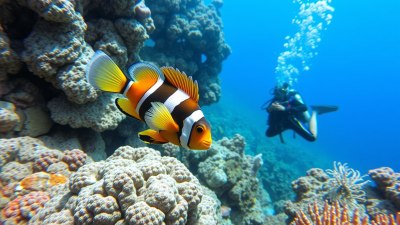What to Expect When Diving in the Red Sea
Discover the wonders of diving in the Red Sea, from vibrant marine life to stunning underwater landscapes.

Image created with Flux Schnell
The Red Sea, known for its crystal clear waters and incredible biodiversity, attracts scuba divers from around the globe. This remarkable body of water, bordered by Egypt, Sudan, Saudi Arabia, and Jordan, is a diver's paradise, offering unique experiences that cater to all levels of expertise. Whether you are a seasoned diver or a novice eager to explore underwater realms, the Red Sea promises an unforgettable adventure.
1. Marine Biodiversity
One of the primary reasons divers flock to the Red Sea is its rich marine biodiversity. The region is home to over 1,200 species of fish, including the iconic clownfish, lionfish, and the majestic Napoleon wrasse. Moreover, more than 200 species of hard and soft corals populate the sea, creating stunning underwater gardens. The biodiversity is not only plentiful but also unique, with many species found nowhere else on Earth. Diving here presents opportunities to observe vibrant schools of fish dancing gracefully among intricate coral formations, a true testament to nature's beauty.
2. Visibility and Water Temperature
The Red Sea is famed for its exceptional visibility, often reaching up to 40 meters (131 feet). This immense clarity allows divers to appreciate the colors and details of the underwater ecosystem fully. The water temperature fluctuates between 21°C (70°F) in the winter and 30°C (86°F) in the summer, making it a comfortable year-round diving destination. Wetsuits may be necessary during the cooler months, but in the summer, a simple shorty may suffice, allowing for an exhilarating dive experience without feeling cold or restricted.
3. Dive Sites
The Red Sea boasts an array of dive sites, each offering unique characteristics and experiences. Renowned locations like Ras Mohammed National Park, the Thistlegorm wreck, and the Blue Hole in Dahab attract divers of all skill levels. The Thistlegorm, a British WWII shipwreck, is particularly popular for its historical significance and the fascinating artifacts that can be found within, such as motorcycles and ammunition. Ras Mohammed features stunning coral reefs teeming with marine life, while the Blue Hole offers exhilarating drop-offs and thrilling caves to explore. Each site is accessible through numerous dive operators, providing options for guided tours or independent diving.
4. Underwater Photography
With its striking colors and diverse marine life, the Red Sea is a photographer's dream. Underwater photographers can capture breathtaking images of corals illuminated by sunlight streaming through the water, schools of fish creating mesmerizing patterns, and the occasional sighting of larger species like sharks and dolphins. Many dive centers offer courses in underwater photography, allowing divers to enhance their skills while exploring the stunning marine environment. If you're a photography enthusiast, investing in a good underwater camera system will pay off with the incredible shots you'll capture.
5. Encounters with Marine Life
Diving in the Red Sea offers numerous opportunities to encounter a wide array of marine species. Divers may have the chance to swim alongside gentle giants like the whale shark or spot the elusive mantas gliding gracefully through the water. Sea turtles are common sights, often curiously approaching divers as they explore their domain. For those fascinated by larger predators, there are even opportunities to safely encounter species like grey reef sharks. Each dive can be an exciting adventure filled with the thrill of unexpected wildlife interactions, keeping divers enchanted under the waves.
6. Safety and Guidelines
Although diving in the Red Sea is generally safe, it’s vital to follow essential safety guidelines. Ensure that your diving equipment is in excellent condition, and always check weather conditions before heading out. Familiarize yourself with the specifics of each dive site, including depth, currents, and marine regulations. Joining a reputable dive operator can enhance safety, as they provide experienced guides who are knowledgeable about local waters. Additionally, divers should be aware of the importance of marine conservation and adhere to best practices: avoid touching corals, do not feed marine life, and respect the underwater ecosystem.
7. Environmental Conservation
The Red Sea's natural beauty is increasingly threatened by overfishing, pollution, and climate change. Many dive centers are now actively promoting marine conservation efforts, encouraging divers to participate in reef clean-ups and educating them about the fragile ecosystems they explore. By becoming involved in conservation activities, divers can help protect marine habitats and spread awareness about the importance of preserving this unparalleled underwater world for future generations. Every small action counts in preserving the Red Sea's majestic biodiversity.
8. Best Time to Dive
The Red Sea can be enjoyed year-round, but some seasons may offer distinct advantages. The peak diving season occurs from May to September, when water temperatures are at their warmest and marine life is abundant, especially during the spawning of many species. However, diving from October to April also provides fantastic opportunities, with fewer crowds and fantastic visibility. Keep in mind that different areas of the Red Sea can experience unique weather patterns, so planning according to your preferred dive site is advisable.
9. Diving Certifications
No prior experience is needed to start diving in the Red Sea. Many dive schools offer courses for beginners, allowing you to earn certifications as you learn. Popular certification agencies include PADI (Professional Association of Diving Instructors) and SSI (Scuba Schools International), which provide structured courses from entry-level to advanced. For those already certified, the Red Sea offers a wealth of guided dive options to enhance your skills and explore new dive sites. Continuing education courses, such as advanced buoyancy or specialty dives, can also help you become a more proficient and knowledgeable diver.
Diving in the Red Sea is an experience that captures the essence of underwater exploration. The combination of unmatched biodiversity, vibrant ecosystems, and thrilling dive sites make it an essential destination for any diving enthusiast. By following safety protocols, respecting the environment, and immersing yourself in this ocean wonderland, you’ll create memories that last a lifetime. Embrace the magic of the Red Sea, where extraordinary aquatic adventures await beneath the surface.











